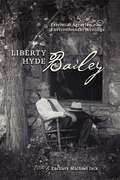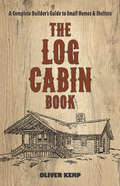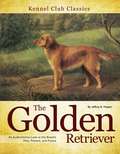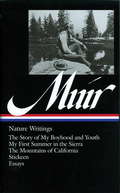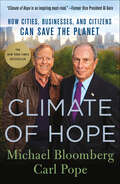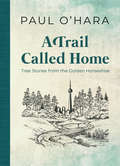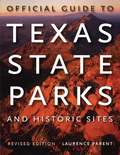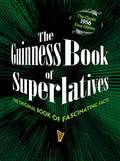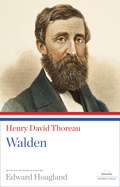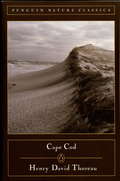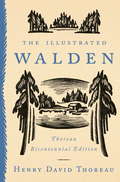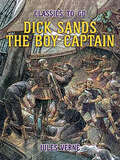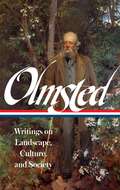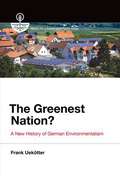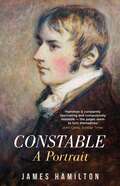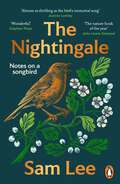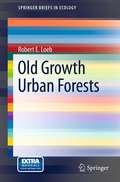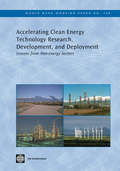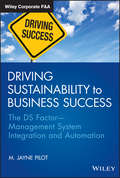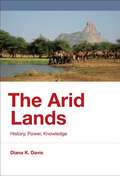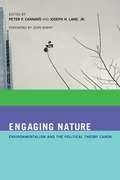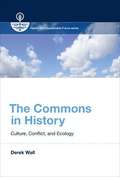- Table View
- List View
Liberty Hyde Bailey: Essential Agrarian and Environmental Writings
by Liberty Hyde Bailey"Nature-study not only educates, but it educates nature-ward; and nature is ever our companion, whether we will or no. Even though we are determined to shut ourselves in an office, nature sends her messengers. The light, the dark, the moon, the cloud, the rain, the wind, the falling leaf, the fly, the bouquet, the bird, the cockroach-they are all ours. If one is to be happy, he must be in sympathy with common things. He must live in harmony with his environment. One cannot be happy yonder nor tomorrow: he is happy here and now, or never. Our stock of knowledge of common things should be great. Few of us can travel. We must know the things at home."—from "The Meaning of the Nature-study Movement""To feel that one is a useful and cooperating part in nature is to give one kinship, and to open the mind to the great resources and the high enthusiasms. Here arise the fundamental common relations. Here arise also the great emotions and conceptions of sublimity and grandeur, of majesty and awe, the uplift of vast desires—when one contemplates the earth and the universe and desires to take them into the soul and to express oneself in their terms; and here also the responsible practices of life take root."—from The Holy EarthBefore Wendell Berry and Aldo Leopold, there was the horticulturalist and botanist Liberty Hyde Bailey (1858–1954). For Wendell Berry, Bailey was a revelation, a symbol of the nature-minded agrarianism Berry himself popularized. For Aldo Leopold, Bailey offered a model of the scholar-essayist-naturalist. In his revolutionary work of eco-theology, The Holy Earth, Bailey challenged the anthropomorphism—the people-centeredness—of a vulnerable world. A trained scientist writing in the lyrical tradition of Emerson, Burroughs, and Muir, Bailey offered the twentieth century its first exquisitely interdisciplinary biocentric worldview; this Michigan farmer's son defined the intellectual and spiritual foundations of what would become the environmental movement.For nearly a half century, Bailey dominated matters agricultural, environmental, and scientific in the United States. He worked both to improve the lives of rural folk and to preserve the land from which they earned their livelihood. Along the way, he popularized nature study in U.S. classrooms, lobbied successfully for women's rights on and off the farm, and bulwarked Teddy Roosevelt's pioneering conservationism.Here for the first time is an anthology of Bailey's most important writings suitable for the general and scholarly reader alike. Carefully selected and annotated by Zachary Michael Jack, this book offers a comprehensive introduction to Bailey's celebrated and revolutionary thinking on the urgent environmental, agrarian, educational, and ecospiritual dilemmas of his day and our own. Culled from ten of Bailey's most influential works, these lyrical selections highlight Bailey's contributions to the nature-study and the Country Life movements. Published on the one-hundredth anniversary of Bailey's groundbreaking report on behalf of the Country Life Commission, Liberty Hyde Bailey: Essential Agrarian and Environmental Writings will inspire a new generation of nature writers, environmentalists, and those who share with Bailey a profound understanding of the elegance and power of the natural world and humanity's place within it.
The The Log Cabin Book: A Complete Builder's Guide to Small Homes and Shelters
by Oliver KempThis vintage guide from over a century ago offers timeless, practical advice on building log cabins. Plans and directions for simple structures are easy enough for amateurs to follow; time and inclination are the only necessary elements. Each of the designs has been tested and allows numberless alterations to suit the builder's tastes and requirements. Instructions range from selecting a site and safe, efficient methods of cutting down trees for building materials to building an ice house and boathouse to furnishing and decorating interiors. Photographs and drawings provide clear images for a variety of wilderness homes, including floor plans for The Block House, Wildwood, Crow's Nest, Idlewild, and other rustic retreats. Rich in nostalgic charm as well as useful applications, this manual offers priceless guidance to handymen, woodworkers, and hunters as well as those interested in small houses, construction, and home history and seekers of off-the-grid, environmentally friendly living.
Se-Quo-Yah
by George Everett FosterPublished in 1885, this is the biography of famed Cherokee Indian, Se-Quo-Yah, the inventor of the Cherokee alphabet.
Golden Retriever
by Jeffrey G. PepperFourth in the Kennel Club Books' Classics series, The Golden Retriever recognizes the ever-popular all-American breed in this one spectacular volume. Written by author, breeder, and judge, Jeffrey G. Pepper, this book's engaging chapters on everything from the breed's accomplishments in performance events, to their participation as service dogs make it much more than just "another breed book." With more than 100 vintage and modern photographs of the breed, this book is a must-have for every Golden owner.
Muir: Nature Writings
by John Muir William CrononIn a lifetime of exploration, writing, and passionate political activism, John Muir made himself America's most eloquent spokesman for the mystery and majesty of the wilderness. A crucial figure in the creation of our national parks system and a visionary prophet of environmental awareness, he was also a master of natural description who evoked with unique power and intimacy the untrammeled landscapes of the American West. Nature Writings collects his most significant and best-loved works in a single volume. The Story of My Boyhood and Youth (1913) is Muir's account of growing up by the sea in Scotland, of coming to America with his family at age eleven, and of his early fascination with the natural world. My First Summer in the Sierra (1911) is his famous account of the spiritual awakening he experienced when, 1869, he first encountered the mountains and valleys of central California. The Mountains of California (1894) draws on half a lifetime of exploration of the high Sierra country to celebrate and evoke the region's lakes, forests, flowers, and animals in a masterpiece of observation and poetic description. Also included are the widely popular "Stickeen" (1909), Muir's affectionate story of an adventure with a dog in Alaska, and a rich selection of essays - including "Yosemite Glaciers", "God's First Temples", "Snow-Storm on Mount Shasta", "The American Forests", and the late appeal "Save the Redwoods" - highlighting various aspects of his career: his exploration of what became Yosemite and Yellowstone national parks and the Grand Canyon, his successful crusades to preserve the wilderness, his early walking tour to Florida, and the Alaska journey of 1879.
Climate of Hope: How Cities, Businesses, and Citizens Can Save the Planet
by Michael Bloomberg Carl PopeNEW YORK TIMES BESTSELLERFrom Mayor Michael Bloomberg and former head of the Sierra Club Carl Pope comes a manifesto on how the benefits of taking action on climate change are concrete, immediate, and immense. They explore climate change solutions that will make the world healthier and more prosperous, aiming to begin a new type of conversation on the issue that will spur bolder action by cities, businesses, and citizens—and even, someday, by Washington."Climate of Hope is an inspiring must read." —Former Vice President Al Gore, Chairman of The Climate Reality Project“Climate change threatens to reshape the future of our world's population centers. Bloomberg and Pope have been leaders on fortifying our cities against this threat, and their book proves that victory is possible—and imperative.” —Leonardo DiCaprio"If Trump is looking for a blueprint, he could not do better than to read a smart new book, Climate of Hope." —Thomas Friedman in The New York Times~The 2016 election left many people who are concerned about the environment fearful that progress on climate change would come screeching to a halt. But not Michael Bloomberg and Carl Pope. Bloomberg, an entrepreneur and former mayor of New York City, and Pope, a lifelong environmental leader, approach climate change from different perspectives, yet they arrive at similar conclusions. Without agreeing on every point, they share a belief that cities, businesses, and citizens can lead—and win—the battle against climate change, no matter which way the political winds in Washington may shift. In Climate of Hope, Bloomberg and Pope offer an optimistic look at the challenge of climate change, the solutions they believe hold the greatest promise, and the practical steps that are necessary to achieve them. Writing from their own experiences, and sharing their own stories from government, business, and advocacy, Bloomberg and Pope provide a road map for tackling the most complicated challenge the world has ever faced. Along the way, they turn the usual way of thinking about climate change on its head: from top down to bottom up, from partisan to pragmatic, from costs to benefits, from tomorrow to today, and from fear to hope.
The Walking Fern
by Matilda Joslyn GageMatilda Joslyn Gage a famous Womans Rights suffragist also wrote many books, speaches, stories and articles.In the 1800's The Walking Fern, is a short story about two young ladies who go out in search of a rare fern, and meet a strange man with a secret past.
A Trail Called Home: Tree Stories from the Golden Horseshoe
by Paul O'HaraAn exploration of trees in the Golden Horseshoe and the stories they tell. Trees define so much of Canadian life, but many people, particularly in the Golden Horseshoe area of Ontario, don’t know that much about them. Granted, it is harder here: there are more trees that are native to this area than anywhere else in Canada. The great storytellers of the landscape, trees are looking glasses into the past. They speak of biology, ecology, and geology, as well as natural and human history. Through a greater understanding of trees, we can become more rooted to the land beneath our feet, and our place in it.
Official Guide to Texas State Parks and Historic Sites
by Laurence ParentSince it was first published in 1996, Official Guide to Texas State Parks and Historic Sites has become Texans' one-stop source for information on great places to view scenic landscapes, tour historical sites, camp, fish, hike, backpack, swim, ride horseback, go rock climbing, and enjoy almost any other outdoor recreation. This revised edition includes five new state parks and historical sites, completely updated information for every park, and many beautiful new photographs. The book is organized by geographical regions to help you plan your trips around the state. For every park, Laurence Parent provides all of the essential information:- The natural or historical attractions of the park- Types of recreation offered- Camping and lodging facilities- Addresses and phone numbers- A locator map- Magnificent color photographs So if you want to watch the sun set over Enchanted Rock, fish in the surf on the beach at Galveston, or listen for a ghostly bugle among the ruins of Fort Lancaster, let this book be your complete guide. Don't take a trip in Texas without it.
The Guinness Book of Superlatives: The Original Book of Fascinating Facts
by BooksImagine the world before Google or Facebook, when books were the only source of recorded fact. Originally published in 1956, The Guinness Book of Superlatives is the very first book in a series that would one day become one of the most well-known and trusted brands in the world—The Guinness Book of World Records. This is the original fun and informative edition, which gathered world facts and records from the year of its publication and prior. Included within are world records and facts from the sectors of: Science Politics Economics Art Architecture Engineering Accidents and disasters Human achievements The natural world And many more! Pick up this entertaining reference book, and expand your knowledge of the world as it was more than sixty years ago.
Walden
by Henry David ThoreauIn 1845 Henry David Thoreau left his pencil-manufacturing business and began building a cabin on the shore of Walden Pond near Concord, Massachusetts. This lyrical yet practical-minded book is at once a record of the 26 months Thoreau spent in withdrawal from society -- an account of the daily minutiae of building, planting, hunting, cooking, and, always, observing nature -- and a declaration of independence from the oppressive mores of the world he left behind. Elegant, witty, and quietly searching, Walden remains the most persuasive American argument for simplicity of life clarity of conscience. For the first time, the authoritative editions of works by major American novelists, poets, scholars, and essayists collected in the hardcover volumes of The Library of America are being published singly in a series of handsome paperback books. A distinguished writer has contributed an introduction for each volume, which also includes a chronology of the author's life and career, an essay on the text, and notes. From the Trade Paperback edition.
Cape Cod
by Henry David Thoreau Paul TherouxThoreau's classic account of his meditative, beach-combing walking trips to Cape Cod in the early 1850s, reflecting on the elemental forces of the sea Cape Cod chronicles Henry David Thoreau's journey of discovery along this evocative stretch of Massachusetts coastline, during which time he came to understand the complex relationship between the sea and the shore. He spent his nights in lighthouses, in fishing huts, and on isolated farms. He passed his days wandering the beaches, where he observed the wide variety of life and death offered up by the ocean. Through these observations, Thoreau discovered that the only way to truly know the sea--its depth, its wildness, and the natural life it contained--was to study it from the shore. Like his most famous work, Walden, Cape Cod is full of Thoreau's unique perceptions and precise descriptions. But it is also full of his own joy and wonder at having stumbled across a new frontier so close to home, where a man may stand and "put all America behind him." Part of the Penguin Nature Library Series Editor: Edward Hoagland With an Introduction by Paul Theroux
The Illustrated Walden: Thoreau Bicentennial Edition
by Henry David ThoreauTo coincide with the bicentennial of Thoreau's birth and TarcherPerigee's publication of Expect Great Things: The Life of Henry David Thoreau, here is a sumptuous rediscovery edition of the first illustrated volume of Thoreau's classic, as originally issued in 1897.In 1897, thirty-five years after Thoreau's death, Houghton Mifflin issued a two-volume "Holiday Edition" of Walden illustrated with thirty remarkable engravings, daguerreotypes, and period photographs. In 1902 the publisher collected the work into a single volume. Now, to mark the bicentennial of Thoreau's birth in 1817, this timeless landmark is reproduced with all of the original illustrations and the complete text of his mystical, practical, magisterial record of a life in the woods.From the Trade Paperback edition.
Dick Sands The Boy Captain: By Jules Verne (Classics To Go #Vol. 109)
by Jules VerneDick Sands, The Boy Captain appeared in 1878, and it is the epic of the slave trade. The description of the wilds of Africa, its adventures and its dangers, the savage hunting both of beasts and men, has always been a favorite among Verne's readers. It contains no marvels, no inventions, but merely, amid stirring scenes and actions seeks to convey two truthful impressions. One is the traveler's teaching the geographical information, the picture of Africa as explorers, botanists, and zoologists have found it. The other is the moral lesson of the awful curse of slavery, its brutalising, horrible influence upon all who come in touch with it, and the absolutely devastating effect it has had upon Africa itself. (Goodreads)
Frederick Law Olmsted: Writings on Landscape, Culture, and Society
by Frederick Law Olmsted Charles BeveridgeThe biggest and best single-volume collection ever published of the fascinating and wide-ranging writings of a vitally important nineteenth century cultural figure whose work continues to shape our world today. Seaman, farmer, abolitionist, journalist, administrator, reformer, conservationist, and without question America's foremost landscape architect and urban planner, Frederick Law Olmsted (1822-1903) was a man of unusually diverse talents and interests, and the arc of his life and writings traces the most significant developments of nineteenth century American history. As this volume reveals, the wide-ranging endeavors Olmsted was involved in--cofounding The Nation magazine, advocating against slavery, serving as executive secretary to the United States Sanitary Commission (precursor to the Red Cross) during the Civil War, championing the preservation of America's great wild places at Yosemite and Yellowstone--emerged from his steadfast commitment to what he called "communitiveness," the impulse to serve the needs of one's fellow citizens. This philosophy had its ultimate expression is his brilliant designs for some of the country's most beloved public spaces: New York's Central Park, Prospect Park in Brooklyn, Boston's "Emerald Necklace," the Biltmore Estate in North Carolina, the grounds of the U.S. Capitol, garden suburbs like Chicago's Riverside, parkways (a term he invented) and college campuses, the "White City" of the 1893 World's Columbian Exposition, and many others. Gathering almost 100 original letters, newspaper dispatches, travel sketches, essays, editorials, design proposals, official reports, reflections on aesthetics, and autobiographical reminiscences, this deluxe Library of America volume is profusely illustrated with a 32-page color portfolio of Olmsted's design sketches, architectural plans, and contemporary photographs. It also includes detailed explanatory notes and a chronology of Olmsted's life and design projects.From the Hardcover edition.
The Greenest Nation?
by Frank UekötterGermany enjoys an enviably green reputation. Environmentalists in other countries applaud its strict environmental laws, its world-class green technology firms, its phase-out of nuclear power, and its influential Green Party. Germans are proud of these achievements, and environmentalism has become part of the German national identity. In The Greenest Nation? Frank Uekötter offers an overview of the evolution of German environmentalism since the late nineteenth century. He discusses, among other things, early efforts at nature protection and urban sanitation, the Nazi experience, and civic mobilization in the postwar years. He shows that much of Germany's green reputation rests on accomplishments of the 1980s, and emphasizes the mutually supportive roles of environmental nongovernmental organizations, corporations, and the state. Uekötter looks at environmentalism in terms of civic activism, government policy, and culture and life, eschewing the usual focus on politics, prophets, and NGOs. He also views German environmentalism in an international context, tracing transnational networks of environmental issues and actions and discussing German achievements in relation to global trends. Bringing his discussion up to the present, he shows the influence of the past on today's environmental decisions. As environmentalism is wrestling with the challenges of the twenty-first century, Germany could provide a laboratory for the rest of the world.
Constable: A Portrait
by James HamiltonONE OF THE TIMES AND SUNDAY TIMES' BEST BOOKS FOR 2022'Eye-opening and full of surprises . . . A treasure' Sunday TimesJohn Constable, the revolutionary nineteenth-century painter of the landscapes and skies of southern England, is Britain's best-loved but perhaps least understood artist.His paintings reflect visions of landscape that shocked and perplexed his contemporaries: attentive to detail, spontaneous in gesture, brave in their use of colour. What we learn from his landscapes is that Constable had sharp local knowledge of Suffolk, a clarity of expression of the skyscapes above Hampstead, an understanding of the human tides in London and Brighton, and a rare ability in his late paintings of Salisbury Cathedral to transform silent suppressed passion into paint.Yet Constable was also an active and energetic correspondent. His letters and diaries - there are over one thousand letters from and to him - reveal a man of passion, opinion and discord, while his character and personality is concealed behind the high shimmering colour of his paintings. They reveal too the lives and circumstances of his brothers and his sisters, his cousins and his aunts, who serve to define the social and economic landscape against which he can be most clearly seen. These multifaceted reflections draw a sharp picture of the person, as well as the painter.James Hamilton's biography reveals a complex, troubled man, and explodes previous mythologies about this timeless artist, and establishes him in his proper context as a giant of European art.
Constable: A Portrait
by James HamiltonONE OF THE TIMES AND SUNDAY TIMES' BEST BOOKS FOR 2022'Eye-opening and full of surprises . . . A treasure' Sunday Times'A biography as rich with colourful characters as any novel' TelegraphJohn Constable, the revolutionary nineteenth-century painter of the landscapes and skies of southern England, is Britain's best-loved but perhaps least understood artist.His paintings reflect visions of landscape that shocked and perplexed his contemporaries: attentive to detail, spontaneous in gesture, brave in their use of colour. What we learn from his landscapes is that Constable had sharp local knowledge of Suffolk, a clarity of expression of the skyscapes above Hampstead, an understanding of the human tides in London and Brighton, and a rare ability in his late paintings of Salisbury Cathedral to transform silent suppressed passion into paint.Yet Constable was also an active and energetic correspondent. His letters and diaries - there are over one thousand letters from and to him - reveal a man of passion, opinion and discord, while his character and personality is concealed behind the high shimmering colour of his paintings. They reveal too the lives and circumstances of his brothers and his sisters, his cousins and his aunts, who serve to define the social and economic landscape against which he can be most clearly seen. These multifaceted reflections draw a sharp picture of the person, as well as the painter.James Hamilton's biography reveals a complex, troubled man, and explodes previous mythologies about this timeless artist, and establishes him in his proper context as a giant of European art.
The Nightingale: ‘The nature book of the year’
by Sam Lee'Wondering and wonderful. The nature book of the year.' JOHN LEWIS-STEMPEL'This lovely book is almost as thrilling as the bird's immortal song - balm for a troubled soul and a glimpse of paradise.' JOANNA LUMLEY______________________________Come to the forest, sit by the fireside and listen to intoxicating song, as Sam Lee tells the story of the nightingale.Every year, as darkness falls upon woodlands, the nightingale heralds the arrival of Spring. Throughout history, its sweet song has inspired musicians, writers and artists around the world, from Germany, France and Italy to Greece, Ukraine and Korea. Here, passionate conservationist, renowned musician and folk expert Sam Lee tells the story of the nightingale. This book reveals in beautiful detail the bird's song, habitat, characteristics and migration patterns, as well as the environmental issues that threaten its livelihood.From Greek mythology to John Keats, to Persian poetry and 'A Nightingale Sang in Berkeley Square', Lee delves into the various ways we have celebrated the nightingale through traditions, folklore, music, literature, from ancient history to the present day. The Nightingale is a unique and lyrical portrait of a famed yet elusive songbird.______________________________'Sam Lee has brought the poetic magic that has long enchanted so many of his musical fans into the written word. Allow yourself to glimpse the world Sam sees, to be part of his love affair with the nightingale, and you will no doubt be delighted.' LILY COLE'A wonderful book.' STEPHEN MOSS'A magical marriage of the lyrical and practical: a book that makes us want to seek out the nightingale and then reveals how we can.' TRISTAN GOOLEY
Old Growth Urban Forests
by Robert E. LoebMillions of urbanites never see primeval forests during their lives except for the old growth forests found in urban parks. Unfortunately, these forests are on the verge of disappearing because arboreal reproduction is lost to human trampling and park administrators and urban foresters do not maintain these "natural" forests. To aid urban foresters and park managers in meeting the challenges, research on old growth forests in urban parks is synthesized in terms of historical ecology to introduce the methods utilized to reveal long-term forest composition changes. The case study of three stands in Fairmount Park, Philadelphia, PA relates pre-chestnut blight tree species densities and post-chestnut blight arboreal changes to fire and visitor trampling. The information gained on how urban old growth forests have developed and changed is used to develop restoration ecology based frameworks to restore species composition and address challenges to forest survival including invasive species.
Accelerating Clean Energy Technology Research, Development, and Deployment
by Jonathan Coony Patrick AvatoClimate change is one of the key challenges of this century. At the same time, energy use-the primary source of climate-altering global greenhouse gas emissions-is increasing at unprecedented rates and is vital to the continued economic growth of developing countries. This poses a serious dilemma that can only be reconciled with new and improved clean energy technologies that balance climate change mitigation and increased energy needs in developing countries. Despite a recent increase in investment, public and private research, development, and deployment (RD&D) funding rates are well below historical levels. In addition, significant barriers impede the ability to develop new technologies, such as the uncertain future value of CO2 emissions, intellectual property rights issues, limited incentives to commercialize technologies for developing countries, and challenges with technology transfer. These factors must be overcome to accelerate innovation in the energy sector. To introduce new thinking to address these concerns, this report examines four cases from outside the energy sector where creative approaches to RD&D have successfully overcome similar barriers. The case studies review approaches to innovation by the Consultative Group on International Agricultural Research, Advanced Market Commitments for Vaccines, the Human Genome Project, and the concept of Distributed Innovation. These case studies show how creative efforts can generate valuable public goods via: (i) international partnerships between public and private actors, (ii) information sharing and intellectual property rights, and (iii) novel financing schemes.
Driving Sustainability to Business Success
by M. Jayne PilotEfficient, compliant management systems pave the road to sustainability through integration and automationThe book addresses the many definitions of sustainability and why CEOs need the links between sustainability, business value, and performance. Business leaders are committed to leading the way, and the book outlines the support of a management system structure and business principles that will drive the accomplishment of their mission. Stakeholder demands on CEOs include many challenges. Investors are assessing companies for financial performance. The shrinking talent pool of employees is looking to work with organizations that support social, environment, and economic operating practices and principles.Great leaders are those that ask questions, who are creative to drive innovation for growth of their company. The Assess-Reflect-Act section on international business principles defined in the book will ask you as the leader thought provoking questions to stimulate action within your organization to bring people, processes, and technology together for business success.Leaders need to transition to smart decisions that are data driven. The company's management system structure is important to build a strong framework for business process operations and automation for global competitiveness. Topics include:Business plans vs management systemsManagement system frameworks: standardization, ISO standards: Quality -- ISO 9001, Environment -- ISO 14001, OHSAS 18001, Integrated Management SystemsThree Steps for Process Development: Identify, Insure, ImproveFocus for the Organization: Compliance Costs, Best Practices, Strategic PlanningSupport -- Resources: Innovation, Engagement, Succession PlanningData as a Valuable ResourceOperation: Process Risks, Management System Control Plan, E-commerce, Enterprise Resource Planning (ERP), Green Awareness-Eco Design, Automated Controls, Cloud ComputingPerformance Evaluation -- Monitor, Measure, Analyze, Audit, Management ReviewCompetitive LandscapeThe constant need to improve internal processes and move toward business sustainability and quality standards is a major stressor for governments and businesses. With one-third of the workforce retiring in the next five to ten years, the need has become more immediate, and the focus has shifted to building a strong framework for business process operations and automation for global competitiveness. This book provides a roadmap to efficient, compliant systems, showing businesses how to build toward sustainability goals and capture key knowledge of the employees involved in the process.
The Arid Lands: History, Power, Knowledge
by Diana K. DavisDeserts are commonly imagined as barren, defiled, worthless places, wastelands in need of development. This understanding has fueled extensive anti-desertification efforts -- a multimillion-dollar global campaign driven by perceptions of a looming crisis. In this book, Diana Davis argues that estimates of desertification have been significantly exaggerated and that deserts and drylands -- which constitute about 41% of the earth's landmass -- are actually resilient and biodiverse environments in which a great many indigenous people have long lived sustainably. Meanwhile, contemporary arid lands development programs and anti-desertification efforts have met with little success. As Davis explains, these environments are not governed by the equilibrium ecological dynamics that apply in most other regions. Davis shows that our notion of the arid lands as wastelands derives largely from politically motivated Anglo-European colonial assumptions that these regions had been laid waste by "traditional" uses of the land. Unfortunately, such assumptions still frequently inform policy. Drawing on political ecology and environmental history, Davis traces changes in our understanding of deserts, from the benign views of the classical era to Christian associations of the desert with sinful activities to later (neo)colonial assumptions of destruction. She further explains how our thinking about deserts is problematically related to our conceptions of forests and desiccation. Davis concludes that a new understanding of the arid lands as healthy, natural, but variable ecosystems that do not necessarily need improvement or development will facilitate a more sustainable future for the world's magnificent drylands.
Engaging Nature
by Peter F. Cannavò John Barry Joseph H. Lane Jr.Contemporary environmental political theory considers the implications of the environmental crisis for such political concepts as rights, citizenship, justice, democracy, the state, race, class, and gender. As the field has matured, scholars have begun to explore connections between Green Theory and such canonical political thinkers as Plato, Machiavelli, Locke, and Marx. The essays in this volume put important figures from the political theory canon in dialogue with current environmental political theory. It is the first comprehensive volume to bring the insights of Green Theory to bear in reinterpreting these canonical theorists.Individual essays cover such classical figures in Western thought as Aristotle, Hume, Rousseau, Mill, and Burke, but they also depart from the traditional canon to consider Mary Wollstonecraft, W. E. B. Du Bois, Hannah Arendt, and Confucius. Engaging and accessible, the essays also offer original and innovative interpretations that often challenge standard readings of these thinkers. In examining and explicating how these great thinkers of the past viewed the natural world and our relationship with nature, the essays also illuminate our current environmental predicament.Essays onPlato Aristotle Niccolò Machiavelli Thomas Hobbes John Locke David Hume Jean-Jacques Rousseau Edmund Burke Mary Wollstonecraft John Stuart Mill Karl Marx W. E. B. Du Bois Martin Heidegger Hannah Arendt Confucius ContributorsSheryl D. Breen, W. Scott Cameron, Peter F. Cannavò, Joel Jay Kassiola, Joseph H. Lane Jr. Timothy W. Luke, John M. Meyer, Özgüç Orhan, Barbara K. Seeber, Francisco Seijo, Kimberly K. Smith, Piers H. G. Stephens, Zev Trachtenberg, Andrew Valls, Harlan Wilson
The Commons in History
by Derek WallAn argument that the commons is neither tragedy nor paradise but can be a way to understand environmental sustainability.
